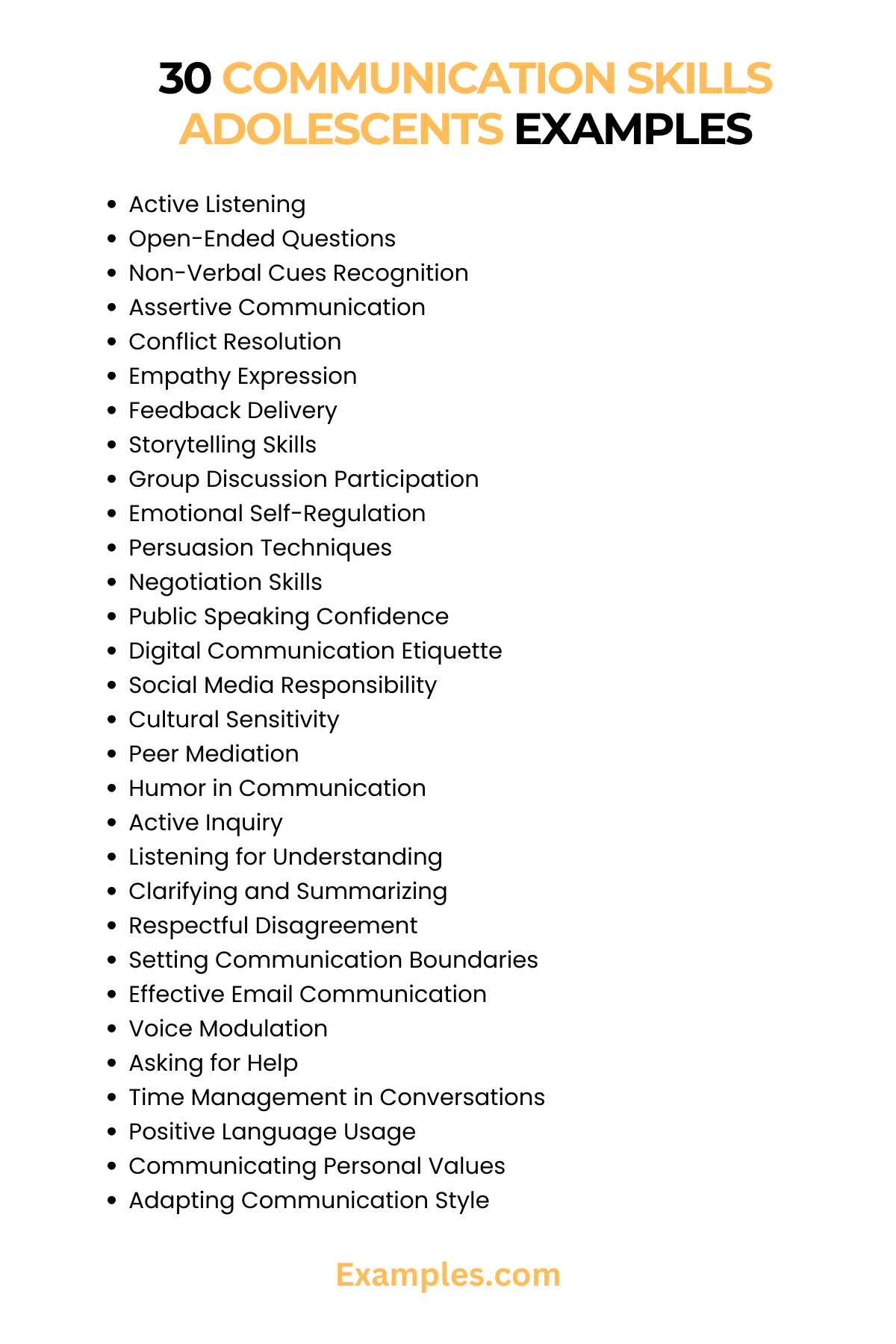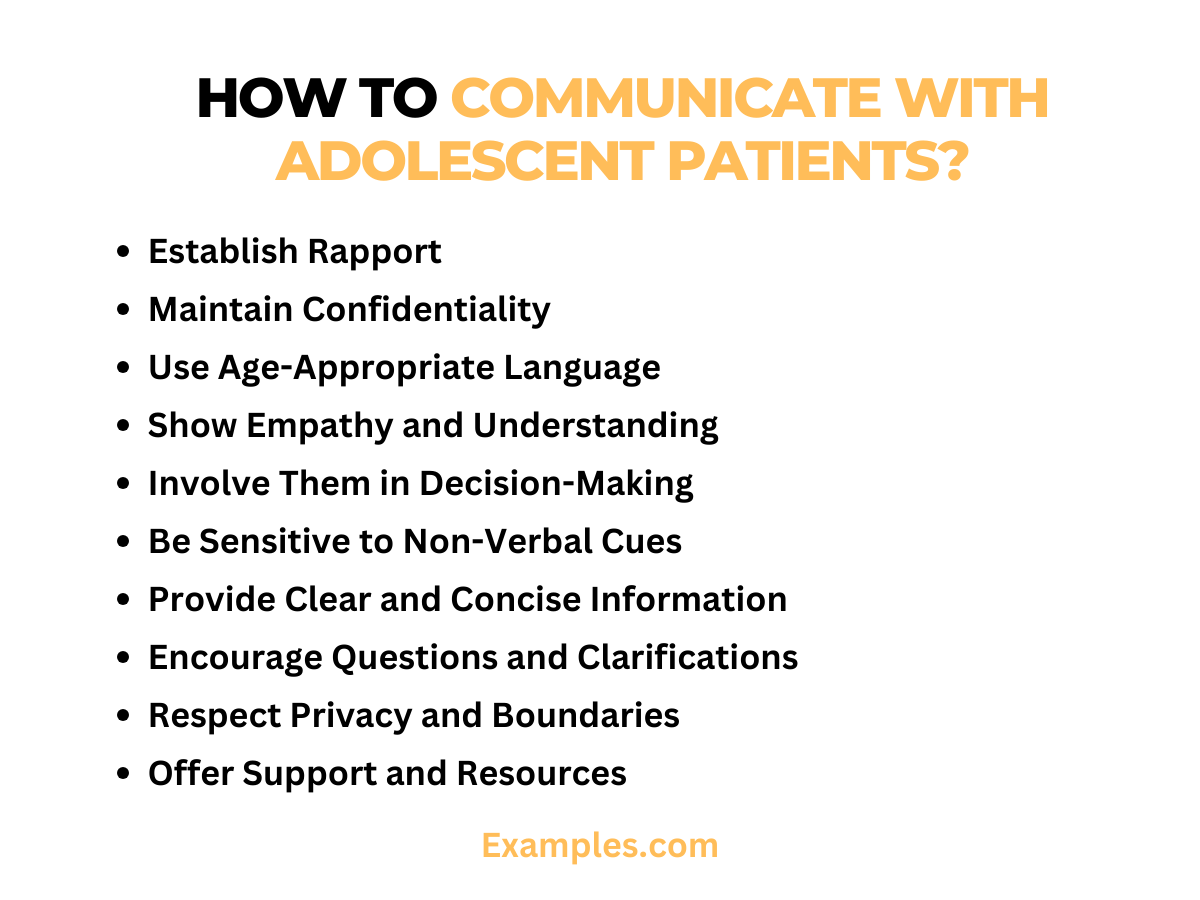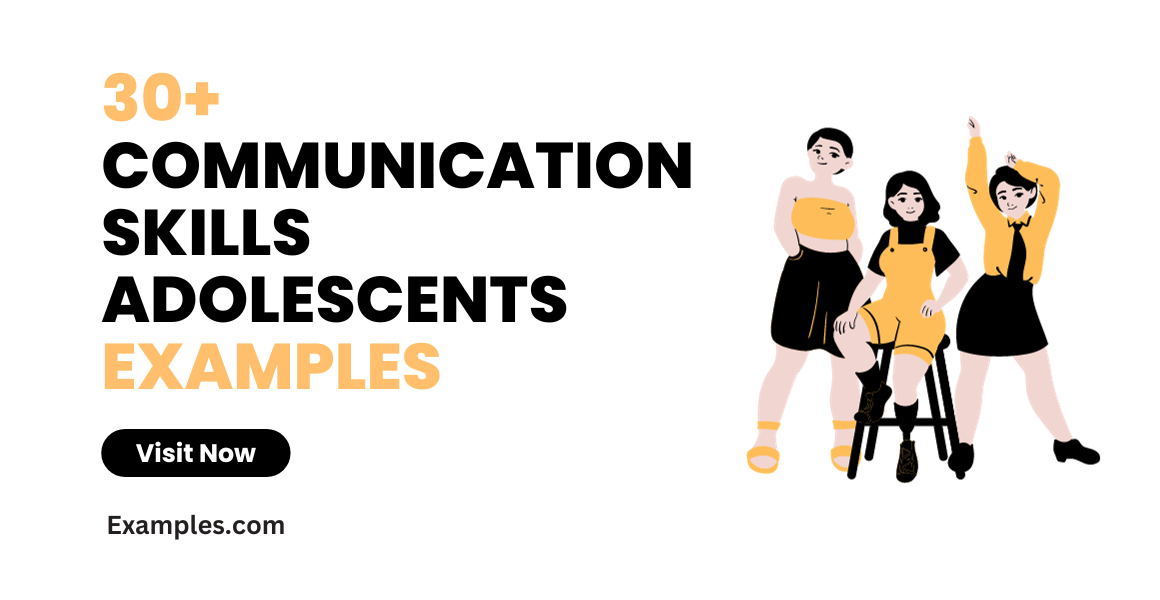29+ Communication Skills Adolescents Examples
In the dynamic journey of adolescence, communication skills play a pivotal role in personal and social development. This comprehensive guide delves into the art of effective communication for adolescents, enriched with practical sentence examples. We explore various communication examples to navigate through the complexities of teenage conversations. Enhancing these skills aids in building confidence, understanding emotions, and fostering healthier relationships, essential for the holistic growth of young adults.
30 Communication Skills Adolescents Examples
Discover the pivotal role of communication in shaping adolescent growth and relationships. This comprehensive list provides 30 unique and distinct examples of communication skills crucial for adolescents. Each example is paired with an explanation, illustrating how effective communication can be fostered in various scenarios. Dive into these insights to enhance understanding and interaction with adolescents.

- Active Listening: Encourage adolescents to practice active listening by paying full attention and showing empathy. This skill fosters deeper understanding and trust in conversations.
- Open-Ended Questions: Teach teens to ask open-ended questions to invite more detailed responses, promoting richer dialogues and better understanding.
- Non-Verbal Cues Recognition: Help adolescents understand and respond to non-verbal cues like facial expressions and body language, enhancing their emotional intelligence.
- Assertive Communication: Guide adolescents to express their needs and opinions assertively, not aggressively, ensuring respectful and clear interactions.
- Conflict Resolution: Equip teens with strategies to resolve disagreements constructively, emphasizing the importance of listening and compromise.
- Empathy Expression: Encourage the expression of empathy to create more meaningful and supportive interactions with peers and adults.
- Feedback Delivery: Teach adolescents how to provide constructive feedback, a crucial skill for their personal and academic development.
- Storytelling Skills: Encourage teens to share experiences through storytelling, which enhances their ability to connect and engage with others.
- Group Discussion Participation: Foster skills in participating effectively in group discussions, promoting collaborative learning and teamwork.
- Emotional Self-Regulation: Guide adolescents in managing their emotions during communication, crucial for maintaining positive interactions.
- Persuasion Techniques: Introduce basic persuasion techniques, helping teens to influence and inspire others in a positive way.
- Negotiation Skills: Teach negotiation skills for reaching mutually beneficial agreements, an essential aspect of interpersonal relations.
- Public Speaking Confidence: Boost confidence in public speaking, aiding adolescents in expressing their ideas clearly and confidently.
- Digital Communication Etiquette: Instruct on digital communication norms and etiquette, essential in today’s tech-driven world.
- Social Media Responsibility: Educate about responsible social media communication, emphasizing the impact of online interactions.
- Cultural Sensitivity: Encourage awareness and sensitivity towards cultural differences in communication styles and preferences.
- Peer Mediation: Introduce the concept of peer mediation to help resolve conflicts among friends constructively.
- Humor in Communication: Teach the appropriate use of humor to build rapport and ease tensions in conversations.
- Active Inquiry: Encourage teens to actively inquire and seek clarity, fostering a deeper understanding and curiosity.
- Listening for Understanding: Focus on listening to understand, not just to respond, for more meaningful and effective communication.
- Clarifying and Summarizing: Teach the skill of clarifying and summarizing points in discussions, ensuring accurate understanding.
- Respectful Disagreement: Guide on how to disagree respectfully, maintaining a constructive and polite discourse.
- Setting Communication Boundaries: Educate on setting healthy boundaries in communication, essential for personal well-being.
- Effective Email Communication: Provide tips for effective email communication, an essential skill in academic and future professional life.
- Voice Modulation: Teach the importance of voice modulation to convey messages more effectively and empathetically.
- Asking for Help: Encourage adolescents to comfortably ask for help or clarification, promoting a supportive communication environment.
- Time Management in Conversations: Guide on managing time effectively in conversations, respecting everyone’s input and schedule.
- Positive Language Usage: Promote the use of positive language to foster a constructive and encouraging communication atmosphere.
- Communicating Personal Values: Assist teens in expressing their personal values and beliefs in a respectful and clear manner.
- Adapting Communication Style: Teach the importance of adapting communication styles to different audiences and situations for maximum effectiveness.
Adolescent Communication Skills Worksheets
Adolescent communication skills worksheets are tailored tools designed to help young individuals enhance their communication skills. These worksheets are an integral part of learning and development for adolescents, providing a structured and interactive approach to understand and effectively apply various aspects of communication. They are especially beneficial in helping teenagers navigate the complexities of interpersonal interactions, emotional expression, and understanding during their formative years.
| Worksheet Number | Focus Area | Objective | Exercise | Reflection |
|---|---|---|---|---|
| 1 | Active Listening Skills | Improve active listening abilities. | Listen to someone for 5 minutes without interrupting, then summarize their message. | Write about how it felt to listen actively and what was learned. |
| 2 | Non-Verbal Communication Analysis | Enhance awareness of non-verbal cues. | Observe a muted conversation and interpret emotions and messages through body language. | Note observations and compare them with the actual conversation if possible. |
| 3 | Assertive Communication Practice | Develop assertive communication skills. | Role-play a scenario to assertively express needs or opinions. | Reflect on the effectiveness and feelings associated with being assertive. |
| 4 | Empathy Building | Cultivate empathy and understand others’ perspectives. | Read a story and write down the perceived feelings and motivations of characters. | Discuss how empathy can change communication styles. |
| 5 | Conflict Resolution Skills | Learn strategies for resolving conflicts constructively. | Think of a recent conflict and write a positive resolution approach. | Analyze the skills needed to resolve conflicts effectively. |
| 6 | Effective Questioning Techniques | Practice using open-ended questions. | Create and use a list of open-ended questions in a real conversation. | Write down the influence of these questions on the conversation. |
| 7 | Digital Communication Etiquette | Understand digital communication norms and etiquette. | Review text messages or emails for tone and clarity improvements. | Reflect on the differences between digital and face-to-face communication. |
| 8 | Public Speaking Skills | Build confidence in public speaking. | Prepare and deliver a speech, then receive feedback. | Write about the experience and identify areas for improvement. |
| 9 | Feedback Delivery and Reception | Learn the art of giving and receiving feedback constructively. | Practice giving and receiving constructive feedback with a peer. | Reflect on how feedback aids personal growth. |
| 10 | Cultural Communication Styles | Appreciate diverse communication styles across cultures. | Research and present on communication norms in a different culture. | Consider how cultural awareness influences communication approaches. |
Nurse Communication with Adolescent Patients
Effective communication between nurses and adolescent patients is crucial in healthcare settings. It involves not only the transmission of medical information but also the establishment of trust and understanding. This guide presents 10 unique and practical examples of communication strategies nurses can use to engage adolescent patients effectively. These examples, rich in empathy and clarity, demonstrate how nurses can enhance their interactions, leading to better healthcare outcomes for young patients.
- Using Humor Appropriately: Lighten the atmosphere with appropriate humor, making the adolescent more comfortable and open to communication.
- Empowering Choice: Offer choices where possible, like selecting the arm for a blood draw. This gives adolescents a sense of control in their care.
- Discussing Hobbies and Interests: Start conversations about their hobbies or interests to build rapport and make them feel at ease.
- Providing Written Material: Give adolescents written materials about their health, allowing them to digest information at their own pace.
- Encouraging Family Involvement: Involve their family in discussions when appropriate, fostering a supportive environment for the adolescent.
- Visual Aids for Explanation: Use visual aids to explain medical procedures or conditions, aiding their understanding and reducing anxiety.
- Teaching Self-Care Techniques: Educate them about self-care practices related to their health, promoting independence and responsibility.
- Respecting Cultural Differences: Acknowledge and respect their cultural background in your communication, ensuring a more personalized and comfortable interaction.
- Using Technology for Engagement: Utilize technology, like apps or websites, to communicate health information in a way that resonates with tech-savvy adolescents.
- Providing a Judgement-Free Zone: Create a judgement-free environment where adolescents feel safe to discuss sensitive health issues.
Communication Skills Among Adolescents Presentation
Explore the nuances of adolescent communication with this in-depth guide. Delve into the complexities of teen interactions, highlighting key aspects like emotional intelligence, digital literacy, and peer influence. This resource offers a comprehensive look at the communication skills among adolescents, blending psychological insights with practical advice to facilitate better understanding and engagement.
- Role-Playing Scenarios: Use role-playing activities to simulate real-life situations, teaching adolescents how to navigate various social interactions effectively.
- Group Discussions on Current Events: Encourage group discussions on current events, promoting critical thinking and respectful debate among adolescents.
- Peer Feedback Sessions: Implement peer feedback sessions, where adolescents can practice giving and receiving constructive criticism.
- Empathy Building Exercises: Conduct exercises aimed at building empathy, like perspective-taking activities, to enhance emotional understanding.
- Conflict Resolution Workshops: Offer workshops on conflict resolution, teaching adolescents how to handle disagreements constructively.
- Digital Communication Challenges: Create scenarios that involve digital communication, highlighting the importance of tone and clarity in texts and emails.
- Public Speaking Opportunities: Provide opportunities for public speaking, enhancing confidence and clarity in verbal communication.
- Listening Skill Activities: Focus on activities that improve listening skills, such as summarizing the other person’s point of view.
- Cultural Communication Exploration: Explore communication styles across different cultures, fostering global awareness and sensitivity.
- Self-Expression Through Art: Use art as a medium for self-expression, helping adolescents communicate feelings and thoughts non-verbally.
How to Communicate with Adolescent Patients?
Communicating with adolescent patients requires a blend of medical professionalism and a deep understanding of adolescent psychology. Here are strategies to effectively communicate with adolescent patients, ensuring their comfort and cooperation:

- Establish Rapport: Begin with casual conversation to build a connection. Talk about interests or general topics before delving into medical discussions.
- Maintain Confidentiality: Assure them of the confidentiality of their medical information, which can encourage openness and trust.
- Use Age-Appropriate Language: Avoid medical jargon. Explain diagnoses and treatments in a way that is easy for them to understand.
- Show Empathy and Understanding: Acknowledge their concerns and fears about medical procedures or diagnoses. Empathy can ease anxiety and build trust.
- Involve Them in Decision-Making: Encourage them to participate in decisions about their care. This empowers them and respects their developing autonomy.
- Be Sensitive to Non-Verbal Cues: Observe their body language. Discomfort or anxiety might be expressed non-verbally.
- Provide Clear and Concise Information: Offer straightforward explanations and instructions. Clarity is key to ensuring they understand their health and treatment plans.
- Encourage Questions and Clarifications: Prompt them to ask questions and express any concerns. This promotes a two-way dialogue and ensures understanding.
- Respect Privacy and Boundaries: Be mindful of their need for privacy, especially during physical examinations.
- Offer Support and Resources: Provide information about support groups, counseling, or other resources suitable for adolescent health concerns.
Effective communication with adolescent patients is essential in fostering a therapeutic relationship and ensuring successful health outcomes. By applying these strategies, healthcare professionals can significantly enhance their interactions with this unique patient group.
What are Effective Ways of Communicating with Adolescents?
Communicating with adolescents can be a dynamic and rewarding experience when approached with the right techniques. Adolescents, navigating a critical developmental stage, require understanding, empathy, and respect in communication. Here are key strategies to enhance your communication skills with this age group:
- Adopt Active Listening: Listen attentively to what they say without rushing to respond. This shows respect for their opinions and encourages open communication.
- Use Open-Ended Questions: Encourage adolescents to express themselves more fully by asking questions that cannot be answered with a simple ‘yes’ or ‘no’.
- Establish Trust and Respect: Build a foundation of trust by respecting their privacy, keeping promises, and acknowledging their growing independence.
- Be Approachable and Non-Judgmental: Create a safe space for them to share their thoughts and feelings without fear of judgment or immediate criticism.
- Understand Non-Verbal Communication: Pay attention to body language and facial expressions, as these often convey more than words.
- Offer Empathy and Support: Show genuine concern and empathy. Acknowledge their feelings, even if you don’t fully understand them.
- Encourage Self-Expression: Support their efforts to express themselves, whether it’s through talking, writing, art, or other forms of self-expression.
- Be Patient and Give Space: Sometimes adolescents need time to process their thoughts. Give them space when needed, but remain available for when they’re ready to talk.
- Communicate Clearly and Concisely: Use clear and straightforward language. Avoid lecturing, as it may lead to disengagement.
- Be a Positive Role Model: Demonstrate effective communication skills in your interactions. Adolescents learn a lot by observing adults.
By integrating these techniques into your interactions, you can significantly improve your communication with adolescents, paving the way for more meaningful and effective dialogues.



